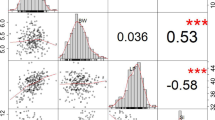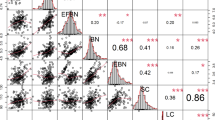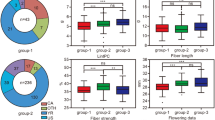Abstract
Upland cotton (Gossypium hirsutum L.) accounts most of the natural fiber production worldwide. Lint percentage (LP) and seed index (SI) are important components of cotton fiber yield, which is a constant breeding goal of cotton. So, the loci underpinning LP and SI should be extensively dissected. Here, one single-locus and four multi-locus genome-wide association study (GWAS) models were employed to detect candidate loci for lint percentage and seed index under seven environments with 196 upland cotton accessions and 41,815 single nucleotide polymorphism (SNP) markers. Totally, 39 and 45 significant quantitative trait locus (QTL) were identified in at least two environments or two models, including 24 previously reported QTLs and six pleiotropic QTLs. Referred to the genome and gene expression database of TM-1, 614 candidate genes were detected for lint percentage and seed index, including 103 genes preferentially expressed in fiber or ovule. The gene Gh_A10G0378, functioned in potassium ion transport, was considered to be related to lint percentage. Collectively, the associated markers and promising genes detected herein will help to elucidate the genetic architecture of lint percentage and facilitate fiber yield improvement in cotton.






Similar content being viewed by others
References
Abdelraheem A, Fang DD, Zhang J (2018) Quantitative trait locus mapping of drought and salt tolerance in an introgressed recombinant inbred line population of upland cotton under the greenhouse and field conditions. Euphytica 214(1):8
Bradbury PJ, Zhang Z, Kroon DE, Casstevens TM, Ramdoss Y, Buckler ES (2007) TASSEL: software for association mapping of complex traits in diverse samples. Bioinformatics 23(19):2633–2635
Cai C, Zhu G, Zhang T, Guo W (2017) High-density 80 K SNP array is a powerful tool for genotyping G hirsutum accessions and genome analysis. BMC Genomics 18(1):654
Cavanagh C, Morell M, Mackay I, Powell W (2008) From mutations to MAGIC: resources for gene discovery, validation and delivery in crop plants. Curr Opin Plant Biol 11(2):215–221
de los Campos G, Vazquez AI, Fernando R, Klimentidis YC, Sorensen D (2013) Prediction of complex human traits using the genomic best linear unbiased predictor. PLoS Genet 9(7):e1003608
Dhindsa RS, Beasley CA, Ting IP (1975) Osmoregulation in cotton fiber: accumulation of potassium and malate during growth. Plant Physiol 56(3):394–398
Diouf L, Pan Z, He SP, Gong WF, Jia YH, Magwanga RO, Romy KRE, Rashid HO, Kirungu JN, Du X (2017) High-density linkage map construction and mapping of salt-tolerant QTLs at seedling stage in upland cotton using genotyping by sequencing (GBS). Int J Mol Sci 18(12):2622
Diouf L, Magwanga R, Gong W, He S, Pan Z, Jia Y, Kirungu J, Du X (2018) QTL mapping of fiber quality and yield-related traits in an intra-specific upland cotton using genotype by sequencing (GBS). Int J Mol Sci 19(2):441
Du X, Huang G, He S, Yang Z, Sun G, Ma X, Li N, Zhang X, Sun J, Liu M, Jia Y, Pan Z, Gong W, Liu Z, Zhu H, Ma L, Liu F, Yang D, Wang F, Fan W, Gong Q, Peng Z, Wang L, Wang X, Xu S, Shang H, Lu C, Zheng H, Huang S, Lin T, Zhu Y, Li F (2018) Resequencing of 243 diploid cotton accessions based on an updated a genome identifies the genetic basis of key agronomic traits. Nat Genet 50(6):796–802
Endelman JB, Jannink JL (2012) Shrinkage estimation of the realized relationship matrix. G3: Genes Genom Genet 2(11):1405–1413
Fan L, Wang L, Wang X, Zhang H, Zhu Y, Guo J, Gao W, Geng H, Chen Q, Qu Y (2018) A high-density genetic map of extra-long staple cotton (Gossypium barbadense) constructed using genotyping-by-sequencing based single nucleotide polymorphic markers and identification of fiber traits-related QTL in a recombinant inbred line population. BMC Genomics 19(1):489
Fang L, Wang Q, Hu Y, Jia Y, Chen J, Liu B, Zhang Z, Guan X, Chen S, Zhou B, Mei G, Sun J, Pan Z, He S, Xiao S, Shi W, Gong W, Liu J, Ma J, Cai C, Zhu X, Guo W, Du X, Zhang T (2017) Genomic analyses in cotton identify signatures of selection and loci associated with fiber quality and yield traits. Nat Genet 49(7):1089–1098
Gwathmey CO, Howard DD (1998) Potassium effects on canopy light interception and earliness of no-tillage cotton. Agron J 90:144–149
Hong EP, Park JW (2012) Sample size and statistical power calculation in genetic association studies. Genomics Inform 10(2):117–122
Huang C, Nie X, Shen C, You C, Li W, Zhao W, Zhang X, Lin Z (2017) Population structure and genetic basis of the agronomic traits of upland cotton in China revealed by a genome-wide association study using high-density SNPs. Plant Biotechnol J 15(11):1374–1386
Islam MS, Zeng L, Thyssen GN, Delhom CD, Kim HJ, Li P, Fang DD (2016) Mapping by sequencing in cotton (Gossypium hirsutum) line MD52ne identified candidate genes for fiber strength and its related quality attributes. Theor Appl Genet 129(6):1071–1086
Jordan KW, Wang S, Lun Y, Gardiner LJ, MacLachlan R, Hucl P, Wiebe K, Wong D, Forrest KL, Consortium I, Sharpe AG, Sidebottom CH, Hall N, Toomajian C, Close T, Dubcovsky J, Akhunova A, Talbert L, Bansal UK, Bariana HS, Hayden MJ, Pozniak C, Jeddeloh JA, Hall A, Akhunov E (2015) A haplotype map of allohexaploid wheat reveals distinct patterns of selection on homoeologous genomes. Genome Biol 16(1):48
Li C, Dong Y, Zhao T, Li L, Li C, Yu E, Mei L, Daud MK, He Q, Chen J, Zhu S (2016) Genome-wide SNP linkage mapping and QTL analysis for fiber quality and yield traits in the upland cotton recombinant inbred lines population. Front Plant Sci 7:1356. https://doi.org/10.3389/fpls201601356
Li C, Fu Y, Sun R, Wang Y, Wang Q (2018a) Single-locus and multi-locus genome-wide association studies in the genetic dissection of fiber quality traits in upland cotton (Gossypium hirsutum L.). Front. Plant Sci 9. https://doi.org/10.3389/fpls.2018.01083
Li C, Zhao T, Yu H, Li C, Deng X, Dong Y, Zhang F, Zhang Y, Mei L, Chen J, Zhu S (2018b) Genetic basis of heterosis for yield and yield components explored by QTL mapping across four genetic populations in upland cotton. BMC Genomics 19(1):910
Liu R, Gong J, Xiao X, Zhang Z, Li J, Liu A, Lu Q, Shang H, Shi Y, Ge Q, Iqbal MS, Deng X, Li S, Pan J, Duan L, Zhang Q, Jiang X, Zou X, Hafeez A, Chen Q, Geng H, Gong W, Yuan Y (2018) GWAS analysis and QTL identification of fiber quality traits and yield components in upland cotton using enriched high-density SNP markers. Front Plant Sci 9. https://doi.org/10.3389/fpls201801067
Ma L, Liu M, Yan Y, Qing C, Zhang X, Zhang Y, Long Y, Wang L, Pan L, Zou C, Li Z, Wang Y, Peng H, Pan G, Jiang Z, Shen Y (2018a) Genetic dissection of maize embryonic callus regenerative capacity using multi-locus genome-wide association studies. Front Plant Sci 9:561
Ma Z, He S, Wang X, Sun J, Zhang Y, Zhang G, Wu L, Li Z, Liu Z, Sun G, Yan Y, Jia Y, Yang J, Pan Z, Gu Q, Li X, Sun Z, Dai P, Liu Z, Gong W, Wu J, Wang M, Liu H, Feng K, Ke H, Wang J, Lan H, Wang G, Peng J, Wang N, Wang L, Pang B, Peng Z, Li R, Tian S, Du X (2018b) Resequencing a core collection of upland cotton identifies genomic variation and loci influencing fiber quality and yield. Nat Genet 50:803–813. https://doi.org/10.1038/s41588-018-0119-7
Misra G, Badoni S, Anacleto R, Graner A, Alexandrov N, Sreenivasulu N (2017) Whole genome sequencing-based association study to unravel genetic architecture of cooked grain width and length traits in rice. Sci Rep-UK 7(1):12478. https://doi.org/10.1038/s41598-017-12778-6
Mullins GL, Reeves DW, Burmester CH, Bryant HH (1994) In-row subsoiling and potassium placement effects on root growth and potassium content of cotton. Agron J 86:136–139
Ozkuru E, Ates D, Nemli S, Erdogmus S, Karaca N, Yilmaz H, Yagmur B, Kartal C, Tosun M, Ocak OO, Otles S, Kahriman A, Tanyolac MB (2019) Genome-wide association studies of molybdenum and selenium concentrations in C arietinum and C reticulatum seeds. Mol Breeding 39(3):46
Palanga KK, Jamshed M, Rashid M, Gong J, Li J, Iqbal MS, Liu A, Shang H, Shi Y, Chen T, Ge Q, Zhang Z, Dilnur T, Li W, Li P, Gong W, Yuan Y (2017) Quantitative trait locus mapping for Verticillium wilt resistance in an upland cotton recombinant inbred line using SNP-based high density genetic map. Front Plant Sci 8:382
Pettigrew WT (2003) Relationship between insufficient potassium and crop maturity in cotton. Agron J 95:1323–1329
Pettigrew WT (2008) Potassium influences on yield and quality production for maize, wheat, soybean and cotton. Physiol Plant 133(4):670–681
Qi H, Wang N, Qiao W, Xu Q, Zhou H, Shi J, Yan G, Huang Q (2017) Construction of a high-density genetic map using genotyping by sequencing (GBS) for quantitative trait loci (QTL) analysis of three plant morphological traits in upland cotton (Gossypium hirsutum L). Euphytica 213(4):83
Rimbert H, Darrier B, Navarro J, Kitt J, Choulet F, Leveugle M, Duarte J, Rivière N, Eversole K, on behalf of The International Wheat Genome Sequencing C, on behalf The Breed Wheat C, Le Gouis J, Davassi A, Balfourier F, Le Paslier M-C, Berard A, Brunel D, Feuillet C, Poncet C, Sourdille P, Paux E (2018) High throughput SNP discovery and genotyping in hexaploid wheat. PLoS One 13(1):e0186329. https://doi.org/10.1371/journalpone0186329
Said JI, Knapka JA, Song M, Zhang J (2015a) Cotton QTLdb: a cotton QTL database for QTL analysis, visualization, and comparison between Gossypium hirsutum and G. hirsutum × G. barbadense populations. Mol Genet Genomics 290:1615–1625
Said JI, Song M, Wang H, Lin Z, Zhang X, Fang DD, Zhang J (2015b) A comparative meta-analysis of QTL between intraspecific Gossypium hirsutum and interspecific G. hirsutum× G. barbadense populations. Mol Genet Genomics 290(3):1003–1025
Saïdou AA, Thuillet AC, Couderc M, Mariac C, Vigouroux Y (2014) Association studies including genotype by environment interactions: prospects and limits. BMC Genet 15:3. https://doi.org/10.1186/1471-2156-15-3
Shi Y, Li W, Li A, Ge R, Zhang B, Li J, Liu G, Li J, Liu A, Shang H, Gong J, Gong W, Yang Z, Tang F, Liu Z, Zhu W, Jiang J, Yu X, Wang T, Wang W, Chen T, Wang K, Zhang Z, Yuan Y (2015) Constructing a high-density linkage map for Gossypium hirsutum× Gossypium barbadense and identifying QTLs for lint percentage. J Integr Plant Biol 57(5):450–467
Song C, Li W, Pei X, Liu Y, Ren Z, He K, Zhang F, Sun K, Zhou X, Ma X, Yang D (2019) Dissection of the genetic variation and candidate genes of lint percentage by a genome-wide association study in upland cotton. Theor Appl Genet:1–12
Spindel JE, Begum H, Akdemir D, Collard B, Redoña E, Jannink JL, McCouch S (2016) Genome-wide prediction models that incorporate de novo GWAS are a powerful new tool for tropical rice improvement. Heredity 116(4):395–408
Su J, Ma Q, Li M, Hao F, Wang C (2018) Multi-locus genome-wide association studies of fiber-quality related traits in Chinese early-maturity upland cotton. Front Plant Sci 9. https://doi.org/10.3389/fpls201801169
Sun Z, Wang X, Liu Z, Gu Q, Zhang Y, Li Z, Ke H, Yang J, Wu J, Wu L, Zhang G, Zhang C, Ma Z (2018) A genome-wide association study uncovers novel genomic regions and candidate genes of yield-related traits in upland cotton. Theor Appl Genet 131(11):2413–2425
Tamba CL, Ni YL, Zhang YM (2017) Iterative sure independence screening EM-Bayesian LASSO algorithm for multi-locus genome-wide association studies. PLoS Comput Biol 13(1):e1005357
Tsialtas IT, Shabala S, Baxevanos D, Matsi T (2016) Effect of potassium fertilization on leaf physiology, fiber yield and quality in cotton (Gossypium hirsutum L) under irrigated Mediterranean conditions. Field Crop Res 193:94–103
Wang H, Huang C, Zhao W, Dai B, Shen C, Zhang B, Li D, Lin Z (2016a) Identification of QTL for fiber quality and yield traits using two immortalized backcross populations in upland cotton. PLoS One 11(12):e0166970
Wang SB, Feng JY, Ren WL, Huang B, Zhou L, Wen YJ, Zhang J, Dunwell JM, Xu S, Zhang YM (2016b) Improving power and accuracy of genome-wide association studies via a multi-locus mixed linear model methodology. Sci Rep-UK 6:19444. https://doi.org/10.1038/srep19444
Wang X, Wang H, Liu S, Ferjani A, Li J, Yan J, Yan X, Qin F (2016c) Genetic variation in ZmVPP1 contributes to drought tolerance in maize seedlings. Nat Genet 48(10):1233–1241
Wen YJ, Zhang H, Ni YL, Huang B, Zhang J, Feng JY, Wang SB, Dunwell JM, Zhang YM, Wu R (2017) Methodological implementation of mixed linear models in multi-locus genome-wide association studies. Brief Bioinform 19(4):700–712. https://doi.org/10.1093/bib/bbw145
Yu J, Pressoir G, Briggs WH, Vroh Bi I, Yamasaki M, Doebley JF, McMullen MD, Gaut BS, Nielsen DM, Holland JB, Kresovich S, Buckler ES (2006) A unified mixed-model method for association mapping that accounts for multiple levels of relatedness. Nat Genet 38(2):203–208
Yu J, Jung S, Cheng CH, Ficklin SP, Lee T, Zheng P, Jones D, Percy R, Main D (2014) CottonGen: a genomics, genetics and breeding database for cotton research. Nucleic Acids Res 42(D1):D1229–D1236
Yuan Y, Wang X, Wang L, Xing H, Wang Q, Saeed M, Tao J, Feng W, Zhang G, Song XL, Sun XZ (2018) Genome-wide association study identifies candidate genes related to seed oil composition and protein content in Gossypium hirsutum L. Front Plant Sci 9:1359
Yuan Y, Zhang H, Wang L, Xing H, Mao L, Tao J, Wang X, Feng W, Wang Q, Wang H, Wei Z, Zhang G, Song XL, Sun XZ (2019) Candidate quantitative trait loci and genes for fiber quality in Gossypium hirsutum L. detected using single-and multi-locus association mapping. Ind Crop Prod 134:356–369
Zhang YM, Tamba CL (2018) A fast mrMLM algorithm for multi-locus genome-wide association studies. bioRxiv 341784. https://doi.org/10.1101/341784
Zhang T, Hu Y, Jiang W, Fang L, Guan X, Chen J, Zhang J, Saski CA, Scheffler BE, Stelly DM, Hulse-Kemp AM, Wan Q, Liu B, Liu C, Wang S, Pan M, Wang Y, Wang D, Ye W, Chang L, Zhang W, Song Q, Kirkbride RC, Chen X, Dennis E, Llewellyn DJ, Peterson DG, Thaxton P, Jones DC, Wang Q, Xu X, Zhang H, Wu H, Zhou L, Mei G, Chen S, Tian Y, Xiang D, Li X, Ding J, Zuo Q, Tao L, Liu Y, Li J, Lin Y, Hui Y, Cao Z, Cai C, Zhu X, Jiang Z, Zhou B, Guo W, Li R, Chen ZJ (2015) Sequencing of allotetraploid cotton (Gossypium hirsutum L acc TM-1) provides a resource for fiber improvement. Nat Biotechnol 33(5):531–537
Zhang J, Feng JY, Ni YL, Wen YJ, Niu Y, Tamba CL, Yue C, Song Q, Zhang YM (2017a) pLARmEB: integration of least angle regression with empirical Bayes for multilocus genome-wide association studies. Heredity 118(6):517–524
Zhang X, Zhang J, He X, Wang Y, Ma X, Yin D (2017b) Genome-wide association study of major agronomic traits related to domestication in peanut. Front Plant Sci 8:1611
Zhou Z, Jiang Y, Wang Z, Gou Z, Lyu J, Li W, Yu Y, Shu L, Zhao Y, Ma Y, Fang C, Shen Y, Liu T, Li C, Li Q, Wu M, Wang M, Wu Y, Dong Y, Wan W, Wang X, Ding Z, Gao Y, Xiang H, Zhu B, Lee SH, Wang W, Tian Z (2015) Resequencing 302 wild and cultivated accessions identifies genes related to domestication and improvement in soybean. Nat Biotechnol 33(4):408–414
Funding
This research was financially supported by the Natural Science Foundation of Shandong Province (ZR2017MC057), the System of Modern Agriculture Industrial Technology of Shandong Province (SDAIT-03-03/05), the Major Projects for Transgenic Breeding of China (2017ZX08005-004-006), the National Key Research and Development Program of China (2018YFD0100303), and the National Natural Science Foundation of China (31601253). We thank all the foundation of economic support.
Author information
Authors and Affiliations
Contributions
XLS and XZS designed the experiments. HX, YY, and XLS wrote the manuscript. HX, YY, HZ, LW, LM, JT, XW, WF, HW, QW, ZW, XL, ZL, and GZ helped in collecting phenotype data. YY, HX, and HZ analyzed the results. HX, YY, and HZ performed most of the experiments and contributed equally to this work. All authors read and approved the final manuscript.
Corresponding authors
Ethics declarations
Conflict of interest
The authors declare that they have no conflict of interest.
Additional information
Publisher’s note
Springer Nature remains neutral with regard to jurisdictional claims in published maps and institutional affiliations.
Rights and permissions
About this article
Cite this article
Xing, H., Yuan, Y., Zhang, H. et al. Multi-environments and multi-models association mapping identified candidate genes of lint percentage and seed index in Gossypium hirsutum L.. Mol Breeding 39, 149 (2019). https://doi.org/10.1007/s11032-019-1063-7
Received:
Accepted:
Published:
DOI: https://doi.org/10.1007/s11032-019-1063-7




